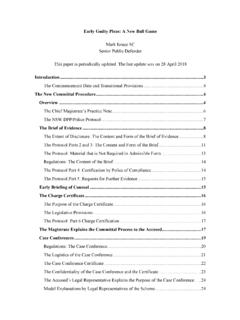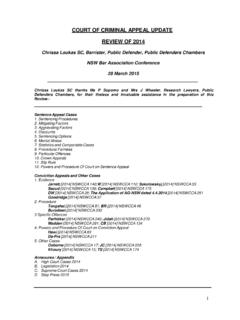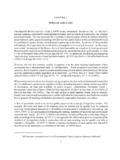Transcription of JOINT CRIMINAL ENTERPRISE 1 - …
1 1 JOINT CRIMINAL ENTERPRISE1 1. Crimes are often committed by more than one person, in various combinations of connection with one another and the offending. But it is essential that just limits are placed on functional and coherent theories of liability for those who have not physically committed the crime charged2. In Darkan v The Queen (2006) 227 CLR 373 Gleeson CJ, Gummow, Heydon and Crennan JJ said at 397 [76]: Further, whatever the common law in the late 19th century was in relation to the problem dealt with by s 8 of the Code, it is clear that now at common law an accessory is liable if the principal offender's crime is "foreseen as a possible incident of the common unlawful ENTERPRISE ": Chan Wing-Siu v The Queen [1985] AC 168 at 175.
2 Although the law has long recognised accessorial liability, it has also long attempted to lay down limits to the accessorial liability of a person who shared a common purpose with a wrongdoer, or who instigated a wrongdoer to commit a crime. The alleged accessory is not to be liable for everything a principal offender did, either vicariously or absolutely. Over time the law has employed different techniques for placing accessorial liability within just limits while continuing to give it substantial room for operation. The common law protects against excessively wide liability by demanding actual foresight, albeit of a possibility.
3 2. The High Court in Darkan was dealing with s 8 of the CRIMINAL Code (Qld) which, like the other Code states, creates liability in ways different from the common law. In NSW and South Australia state offences continue to be governed by the common law. Victoria has legislatively abolished the common law of complicity and in its place imposed liability on persons "involved in the commission of an offence . The Commonwealth CRIMINAL Code addresses related issues in ss (complicity and common purpose), (commission by proxy) and ( JOINT commission) and are not further discussed in this paper.
4 3. Complicity in crime may be established by intentionally encouraging or assisting another s crime. Although accessories (before the fact or alternatively at the fact / principals in the second degree) are prosecuted as principals (see Crimes Act 1900 (NSW) ss 345, 346, 351, 351B), their liability is derivative and the prosecution need to 1 This is an updated version of a talk given in March 2017 2 Lord Bingham in R v Rahman [2009] 1 AC 129 said at 145 Any coherent CRIMINAL law must develop a theory of accessory liability which will embrace those whose responsibility merits conviction and punishment even though they are not the primary offenders.
5 2 prove that the crime has been committed by the alleged principal. This does not mean the principal needs to have been convicted of the 4. JOINT CRIMINAL ENTERPRISE liability offers a different and often complementary way of describing complicity in crime. There are pursuant to this doctrine really three layers of liability for those who mutually embark on a CRIMINAL ENTERPRISE :4 (i) If the crime that is the object of the ENTERPRISE is committed while the agreement remains on foot, all the parties to the agreement are equally guilty regardless of the part that each has played in the conduct that constitutes the actus An accused can be shown to be guilty of a crime on this basis although the Crown cannot show what the person has actually done himself or herself.
6 The Crown needs to prove agreement and participation in furthering the agreement. Presence at the commission of the offence may be sufficient to demonstrate participation, but it is not This first principle is reasonably uncontentious. This first most basic aspect of JOINT CRIMINAL ENTERPRISE requires no contemplation of the individual acts to be done to perform the crime agreed upon. This is the concept of JOINT CRIMINAL ENTERPRISE in its simplest form. (ii) Each party is also guilty of any other crime (the incidental crime ) committed by a co-venturer that is within the scope of the An incidental crime is within the scope of the agreement if the parties contemplate its commission as a possible incident of the execution of their agreement.
7 This is the principle applied in Johns ( ) v R (1980) 143 CLR 108 ( Johns ). (iii) A party to a JOINT CRIMINAL ENTERPRISE who foresees, but does not agree to, the commission of the incidental crime in the course of carrying out the agreement and who, with that awareness, continues to participate in the ENTERPRISE is liable for the incidental offence ( extended JOINT CRIMINAL ENTERPRISE liability ). This is the 3 See discussion in Likiardopoulos v The Queen [2012] HCA 37; (2012) 247 CLR 265 4 Apparent from the caselaw generally but recently made clear in paragraph 4 of the plurality judgment in Miller v The Queen [2016] HCA 30; 334 ALR 1 ( Miller ) 5 See also McAuliffe v The Queen (1995) 183 CLR 108 at 114, Gillard at 35 [110] (Hayne J), Huynh v The Queen [2013] HCA 6; (2013) 295 ALR 624 at [37].
8 And as described by the Privy Council in Brown v The State (Trinidad & Tobago) [2003] UKPC 10 at [8] and [13], as the plain vanilla version (as quoted by Kirby J in Keenan v The Queen (2009) 236 CLR 397 (dissenting as to the orders made) at [3] and Lord Bingham in Rahman at 145). 6 See analysis in Dickson v R [2017] NSWCCA 78, relating to a series of aggravated break and enter and theft charges involving multiple offenders. 7 See also McAuliffe at 114, Clayton v The Queen (2006) 231 ALR 500 ( Clayton ) at 504 [17] 3 extended principle applied in McAuliffe v The Queen (1995) 183 CLR 108 ( McAuliffe ) at 115-8, affirmed in Miller v The Queen [2016] HCA 30; (2016) 259 CLR 380; (2016) 334 ALR 1; (2016) 90 ALJR 918; (2016) 251 A Crim R 105 ( Miller ).
9 5. Although the High Court in Miller described the second (or the first and second) as JOINT CRIMINAL ENTERPRISE liability , the second has not usually been described this way in NSW. The case emanated from South Australia, and it was South Australian terminology that was adopted. Although the distinction between the second and third is conceptually important, and was the subject of the decisions in R v Jogee; Ruddock v The Queen ( Jogee ) [2016] 2 WLR 681 and Miller; in practical terms the distinction between the second and third on the one hand, and the first on the other, is much wider.
10 Very often the second and third are referred to as though the same. The second and third were both generally before Miller referred to in NSW as common purpose , extended JOINT CRIMINAL ENTERPRISE or extended common purpose liability. Sometimes they were distinguished as traditional JOINT ENTERPRISE or common purpose and extended The particular issue in Miller of distinguishing between those cases where the contemplated incidental crime is within or without the agreement does not detract from the fact that usually these are treated as though the In fact the judgment really depends on the suggested similarity between them.














